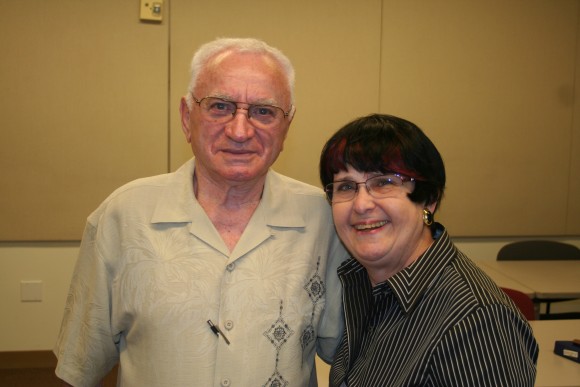
Never To Be Forgotten: Thomas Blatt, April 15, 1927 – October 31, 2015 Fighter for Memory and Justice
November 2, 2015
Tom Blatt was such a force of nature that it seemed unimaginable that there would ever be a time when he would not be with us. Tom spent virtually his entire life fighting–first for survival and then, after the Holocaust, for memory and justice. One of the few survivors of Sobibor, the death camp in which at least 170,000 Jews were murdered, he fought to have the world remember what happened there. He fought to bring the perpetrators to justice. He fought to have the site on which mass murder had occurred be treated with respect so that people and animals would no longer tread upon the ashes and bone fragments of the victims. Among the murdered were Tom’s parents and younger brother.
After the war, Tom fought being dragged into the abyss of depression by the nightmares that came with his memories. Even then, he fought against forgetting so he could witness to what he had seen. He did so in two remarkable books,
Sobibor: The Forgotten Revolt
and his memoir,
From the Ashes of Sobibor: A Story of Survival
; countless talks and lectures; courtroom testimony; interviews and documentaries. No matter the pain caused by remembering, Tom willed himself to do so through writing and speaking around the world, and he willed everyone he met to listen, learn, and guard the memory of what happened at Sobibor.

I met Tom almost twenty years ago. For someone who had every reason to be distrustful of strangers, Tom was perhaps the most trusting person I have ever met. As we were still discussing the possibility of his coming to speak at Chapman University, before we had met in person, and without any advance notice, Tom sent me the typed manuscript for what would become his first book
.
I think he may have entrusted me with his only copy. I am sure he never expected me to cover the pages with questions and edits. He might understandably have been dismissive or even angry. After all, what could I possibly know of the unspeakable events he had witnessed? But for some reason, still a stranger to him, he trusted me and gave my edits more consideration than they probably deserved. He patiently worked through draft after draft–he claimed there were 12 (!) –until we agreed on a final version. By then, we were friends for life. Tom promised me that when I was ready to go to Poland, to see Sobibor for myself, he would go with me as my guide. And so he did, introducing me to people I would never have met otherwise and enabling me to see places that are not on any tourist itinerary. Among them were Izbica, where he was born, and Sobibor, where his life nearly ended. It was a trip that changed my life.
Tom sometimes showed people the spot below his jaw where a bullet remained lodged. Having escaped Sobibor, he was shot by the farmer who had been hiding him and two other escapees and who had decided that protecting Jews was no longer worth the risk. Tom’s companions were killed. Naked and bleeding, Tom survived only by pretending to be dead, exerting an almost superhuman act of will to lie still until his would-be executioners had left.
Maybe that horrific experience partly explains why Tom loved to be on the move. Well into his 80s and with numerous physical ailments, he traveled to Poland and Germany; he testified against John Demjanjuk; he constantly launched himself into new projects that he believed would further memory. Activism, courage, and an indefatigable will to live made Tom the person he was. No matter the odds, he fought. And just as central to his character were kindness and generosity and an unshakeable devotion and loyalty to his family and those he made his friends. I will never know why Tom chose me to be his friend; I only know the gift his friendship has been and will always be to me.
In addition to Tom’s books, his testimony about his experiences is available on both the
USC Shoah Foundation Institute
website and
The 1939 Society
site. The following are two brief but powerful videos on YouTube entitled “Past and Present: History Falsified” which record Tom’s return to Izbica and Sobibor: